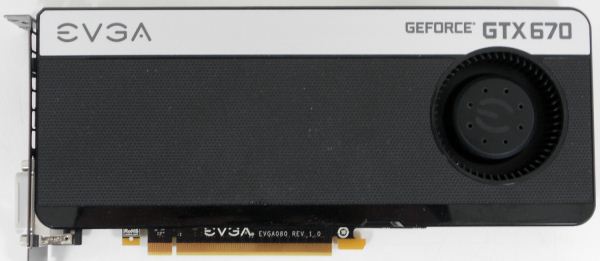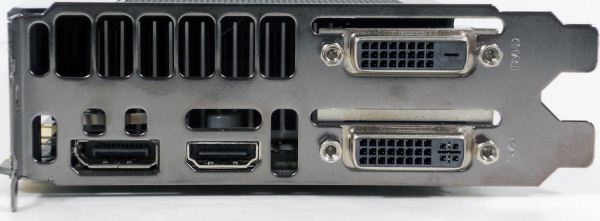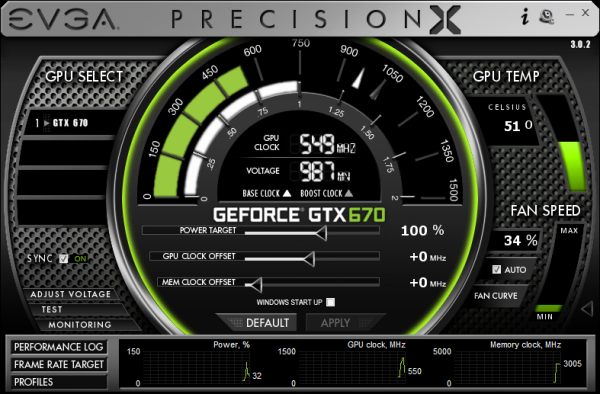NVIDIA GeForce GTX 670 Review Feat. EVGA: Bringing GK104 Down To $400
by Ryan Smith on May 10, 2012 9:00 AM ESTMeet The EVGA GeForce GTX 670 Superclocked
Our second card of the day is EVGA’s GeForce GTX 670 Superclocked, which in EVGA’s hierarchy is their first tier of factory overclocked cards. EVGA is binning GTX 670s and in turn promoting some of them to this tier, which means the GTX 670 Superclocked are equipped with generally better performing chips than the average reference card.
| GeForce GTX 670 Partner Card Specification Comparison | ||||
| EVGA GeForce GTX 670 Superclocked | GeForce GTX 670 (Ref) | |||
| CUDA Cores | 1344 | 1344 | ||
| Texture Units | 112 | 112 | ||
| ROPs | 32 | 32 | ||
| Base Clock | 967MHz | 915MHz | ||
| Boost Clock | 1046MHz | 980MHz | ||
| Memory Clock | 6210MHz | 6008MHz | ||
| Memory Bus Width | 256-bit | 256-bit | ||
| Frame Buffer | 2GB | 2GB | ||
| TDP | 170W | 170W | ||
| Manufacturing Process | TSMC 28nm | TSMC 28nm | ||
| Width | Double Slot | Double Slot | ||
| Length | 9.5" | 9.5" | ||
| Warranty | 3 Years | N/A | ||
| Price Point | $419 | $399 | ||
For the GTX 670 SC, EVGA has given both the core clock and memory clock a moderate boost. The core clock has been increased by 52MHz (6%) to 967MHz base and 66MHz (7%) boost to 1046MHz. Meanwhile the memory clock has been increased by 202MHz (3%) to 6210MHz.
Other than the clockspeed changes, the GTX 670 SC is an almost-reference card utilizing a reference PCB with a slightly modified cooler. EVGA is fabricating their own shroud, but they’ve copied NVIDIA’s reference shroud down to almost the last detail. The only functional difference is that the diameter of the fan intake is about 5mm less, otherwise the only difference is that EVGA has detailed it differently than NVIDIA and used some rounded corners in place of square corners.
The only other change you’ll notice is that EVGA is using their own high flow bracket in place of NVIDIA’s bracket. The high flow bracket cuts away as much metal as possible, maximizing the area of the vents. Though based on our power and temperature readings, this doesn’t seem to have notably impacted the GTX 670 SC.
While we’re on the matter of customized cards and factory overclocks, it’s worth reiterating NVIDIA’s position on factory overclocked cards. Reference and semi-custom cards (that is, cards using the reference PCB) must adhere to NVIDIA’s power target limits. For GTX 670 this is a 141W power target, with a maximum power target of 122% (170W). Fully custom cards with better power delivery circuitry can go higher, but not semi-custom cards. As a result the flexibility in building semi-custom cards comes down to binning. EVGA can bin better chips and use them in cards such as the Superclocked – such as our sample which can go 17 boost bins over the base clock versus 13 bins for our reference GTX 670 – but at the end of the day for stock performance they’re at the mercy of what can be accomplished within 141W/170W.
In any case, as the card is otherwise a reference GTX 670 EVGA is relying on the combination of their factory overclock, their toolset, and their strong reputation for support to carry the card. EVGA has priced the card at $419, $20 over the GTX 670 MSRP, in-line with other factory overclocked cards.
On the subject of pricing and warranties, since this is the first EVGA card we’ve reviewed since April 1st, this is a good time to go over the recent warranty changes EVGA has made.
Starting April 1st, EVGA has implemented what they’re calling their new Global Warranty Policy. Starting July 1st, 2011 (the policy is being backdated), all new EVGA cards ship with at least a 3 year warranty. And for the GTX 600 series specifically, so far EVGA has only offered models with a 3 year warranty in North America, which simplifies their product lineup.
To complement the 3 year warranty and replace the lack of longer term warranties, EVGA is now directly selling 2 and 7 year warranty extensions, for a total of 5 and 10 years respectively. So instead of buying a card with a 3 year warranty or a longer warranty, you’ll simply buy the 3 year card and then buy a warranty extension to go with it. However the extended warranty requires that the card be registered and the warranty purchased within 30 days.
The second change is that the base 3 year warranty no longer requires product registration. EVGA has other ways to entice buyers into registering, but they’ll now honor all applicable cards for 3 years regardless of the registration status. At the same time the base 3 year warranty is now a per-product warranty (e.g. a transferable warranty) rather than per-user warranty, so the base warranty will transfer to 2nd hand buyers. The extended warranties however will not.
The third change is how EVGA is actually going to handle the warranty process. First and foremost, EVGA is now allowing cards to be sent to the nearest EVGA RMA office rather than the office for the region the card was purchased from. For example a buyer moving from Europe to North America can send the card to EVGA’s North American offices rather than sending it overseas.
Finally, EVGA is now doing free cross shipping, alongside their existing Advanced RMA program. EVGA will now cross-ship replacement cards for free to buyers. The buyer meanwhile is responsible for paying to ship the faulty card back and putting up collateral on the new card until EVGA receives the old card.
There’s also one quick change to the step-up program that will impact some customers. With the move to purchasing extended warranties, the step-up program is only available to customers who either purchase an extended warranty or purchase an older generation card that comes with a lifetime warranty. Step-up is not available to cards with only the base 3 year warranty.
Moving on, along with EVGA’s new warranty EVGA is bundling the latest version of their GPU utilities, Precision X and OC Scanner X.
Precision X, as we touched upon quickly in our GTX 680 review, is the latest iteration of EVGA’s Precision overclocking & monitoring utility. It’s still based on RivaTuner and along with adding support for the GTX 600 series features (power targets, framerate caps, etc), it also introduces a new UI. Functionality wise it’s still at the top of the pack along with the similarly RivaTuner powered MSI Afterburner. Personally I’m not a fan of the new UI – circular UIs and sliders aren’t particularly easy to read – but it gets the job done.
OC Scanner X has also received a facelift and functionality upgrade of its own. Along with its basic FurMark-ish stress testing and error checking, it now also offers a basic CPU stress test and GPU benchmark.



















414 Comments
View All Comments
Morg. - Friday, May 11, 2012 - link
nice trolling, C. disabling ANY unit is like disabling ANY core on a phenom x3 - or did you really think they only ever disabled core #3 ?CeriseCogburn - Friday, May 11, 2012 - link
You just blew your own point. AMD cpu's are no exception either - as about 50% of the dual core phenom 2's (according to this sites reviewers) successfully unlock into stable quadcores (another large percentage is user error, bios issue, meme incomatibility,etc) - so just CUTTING OFF default on states is not " a failed core" as you so stupidly state.Further, we can use your junk mentality about cores to comment on the recent 6950 - which unlocked - apparently their junk cores are junk wasted wasted crap binned down to 6950 because they sucked so badly they couldn't make themselves into being a 6970, right ?
NO, you are not correct.
I added a couple of amd examples because I noted your ongoing amd fanboyism, so hope to have jolted you from your spewing idiotic FUD with a few thoughts of your favorite little red friends...
Here with the 680 "cut" into a 670 we have a very SMALL percentage of the core becoming not used, hence the chance that it "just happens to be a failed core that couldn't make the 680 grade" is VERY MINISCULE indeed.
The vast majority are just "cut" for the 670, perhaps every single one, since we see they require a high clock and even overclock better than 680's generally and therefore are from a likely refined and tweaked process.
I certainly wish you fanboys wouls stop spreading stupid put down lies, and then of course, only using them against your hated competition.
There is a BIG DIFFERENCE between disabling two of four cores as amd did in so, so many amd cpus - giving them a chance to use a part that is near a full 50% piece of die failure crap (ROFL) - and ...
Disabling one tiny of 8 functional shaders, leaving 7 of 8 useful, and likely in that case, having all 8 useful and just cutting the access.
Given amd's 50 cpu core hacking cutoffs, "failed dies" may in fact apply to that, but NOT to the 670, except by very rare chance indeed.
CeriseCogburn - Friday, May 11, 2012 - link
The GTX680 has been selling just about every day on the egg - the verified reviewers trickle in daily.So, what initially is a zero to the clueless zero who doesn't count not only amazon stock and tiger direct stock but about 50 other online and famous vendors and only looks at just newegg or worse yet just repeats a lie they heard because they liked the sound of it, is not really a zero but a trickle.
Let us know if it goes much past the 2.5 month trickle of the 79xx series, and then add in an extra 2 weeks because of the absolutely pathetic amd lack of decent driver situation that is ongoing.... Yes I'll give nVidia 3 or 4 months since those that are being bought slowly in the opressed US economy at least have all their games working at first and SLI working and even STW2 works - not to mention the added features of target frame rate (use evga precision X) and adaptive v-sync in driver 301.24 out for some time now for ALL nVidia cards all the way back to the hated and dreaded by amd fanboys massively re-released and branded "rebrand" G80 or 8 series GPU's.
You may send nVidia a big thank you email for providing massive ongoing value for their entire user base with awesome driver updating, absolutely AWESOME.
Wreckage - Thursday, May 10, 2012 - link
So AMD now has the 4th fastest card on the market. How far the might have fallen.raghu78 - Thursday, May 10, 2012 - link
You are out of your mind. In fact AMD's competitiveness in the most demanding games has increased. AMD's 4XAA / 8X AA performance in Batman Arkham city has been fixed with the latest drivers.In fact in Batman Arkham city at 8X AA AMD is now faster . check other websites like legitreviews. In Shogun 2 Nvidia's performance has been hit severely due to the latest patch / driver situation and its clearly behind HD 7970 at 2560 x 1600 and 5760 x 1080. In the most demanding games like BF3, Alan Wake, Crysis 2, Batman Arkham City, The Witcher 2, Shogun 2, Anno 2070, the HD 7970 will easily defeat the GTX 680 given that HD 7970 1Ghz - 1.1 Ghz ( Sapphire HD 7970 Dual X, MSI HD 7970 Lightning (1070) , Powercolor PCS+ HD 7970 Vortex II (1100) ) is available in retail.And not to forget the beautiful performance scaling of the HD 7970. Most users are running the HD 7970 OC editions at 1150 Mhz on stock voltage. Some are pushing it to 1250 with extra voltage. The HD 7970 is a true single GPU beast with the raw power, memory bandwidth and size to handle the most demanding games of today and tomorrow.
maximumGPU - Thursday, May 10, 2012 - link
im not sure where you get your info from. Most reviews i read placed the 680 above the 7970.in fact since you mention legitreviews:
" Our testing showed that this card did phenomenally well with DirectX 11 game titles and is currently the overall fastest graphics card for gaming.."
raghu78 - Thursday, May 10, 2012 - link
http://www.legitreviews.com/article/1925/4/"For benchmark testing of Batman: Arkham City we disabled PhysX to keep it fair and ran the game in DirectX 11 mode with 8x MSAA enabled and all the image quality features cranked up. You can see all of the exact settings in the screen captures above. "
Look at the Sapphire HD 7970 Dual X (48 fps) trample the GTX 680 (39 fps)
And if you look at Metro 2033 (DOF with 4X MSAA) . DOF uses compute shaders. really demanding on bandwidth
http://www.legitreviews.com/article/1925/10/
The Sapphire HD 7970 Dual X and MSI HD 7970 Lightning are 19% and 23% faster than GTX 680 respectively.
In the most demanding games the HD 7970 shows its raw power. Whats the point in looking at games doing 100 fps. its for suckers like you who don't think at all. Unless you are into multiplayer combat once you cross 60+ fps it doesn't make any difference in normal gaming. scenarios.
CeriseCogburn - Thursday, May 10, 2012 - link
In a single cherry picked instance after a year of amd driver failure, and likely a current cheat with driver chumming, the amd card has magically tweaked out a long lose into a single win - and suddenly you forgot the months on end we all suffered with our overpriced 7970 crapster crashing on every other game randomly.Way to go with pr fanboy passion.
Now see this http://translate.google.pl/translate?hl=pl&sl=...
Oh well, it was fun while it lasted for a single game. Just remember don't turn up the tesselation, make sure to tweak the tesselation cheater slider in amd's CCC bloated ad serving pig, then keep the head held high as the random crash and hours of reinstalling and fixing the newly discovered bugs from the latest driver keep you occupied. No PhysX, they turned it off in your proof game because amd can't hang. ROFL
I amd and I can't play, crip the game so I can win, because I can't play with the eye candy turned on.
CeriseCogburn - Friday, May 11, 2012 - link
Don't forget about the massive tearing with amd gpu's that is not present on the nVidia implementations.http://hardforum.com/showthread.php?p=1038706634
Then of course almost everyone now recommends 680 in case of going to SLI in the future, because it's so much better than CF, including the reviewer above - so much more important than...
imaginary future 3G never coming lifetime for a single outside the box explicitly setup and tweaked for amd benchmark with just the right settings and game and endless hours searching for the combo to show a single instance... (I guess a couple years of amd fanboys whacking away might find a big lie they can hope to offer)
Wreckage - Thursday, May 10, 2012 - link
The first game you mention is BF3http://www.anandtech.com/show/5818/nvidia-geforce-...
The 670 absolutley destroys the 7970.
You are trying too hard to get into the AMD focus group. Just stick to the material they send you.